Classification, Sources, Functions, Deficiency - Fat soluble vitamins | 11th Biochemistry : Chapter 8 : Vitamins
Chapter: 11th Biochemistry : Chapter 8 : Vitamins
Fat soluble vitamins
Fat soluble vitamins
The
members of this group are vitamin A, vitamin D, vitamin E and vitamin K. All
these vitamins are not soluble in water but are readily soluble in fat. These
vitamins are present in the liver and fatty tissues. These vitamins can be
stored in human body and hence getting too much of these vitamins can also
cause problems.
1. Vitamin A (Retinol):
Vitamin
A or Retinol is a poly isoprenoid compound containing a cyclohexenyl ring (Fig.
8.1) . It is found only in foods of animal origin. It is present in almost all
species of fish, birds and mammals. The precursor of vitamin A, carotenoid is
found in foods of plant origin. The body has the ability to convert carotenoid
compound present in the diet into vitamin A. For example beta carotene found in
vegetables such as carrot is converted into vitamin A by the symmetrical
cleavege by the enzyme β-carotene -15,15’-dioxygenase.

Table
8.1 Comparison of fat and and water soluble vitamins

Sources:
Liver,
oil, butter, milk, egg-yolk, tomato, carrot, green yellow vegetables, spinach
and fruits such as mango and papaya (Figure 8.2).
Meat :
25000 IU / 100 g
Spinach
(Cooked): 1200 IU / 100 g
Beta
Carotene
Carrots
(Cooked) : 2500 IU / 100 g
Drumstick
leaves: 7000-8000 microgram / 100g

Functions of vitamin A:
· Vitamin A plays a significant role in the visual
cycle (as a component of rhodopsin).
· Retinoic acid plays a key role in glycoprotein
synthesis.
· It is essential for the normal structure and
functions of epithelial tissues.
· Retionic acid inhibits the enzyme collagenase and
thus prevents the breakdown of collagen.
· Retinoic acid is essential for sulfation of the
mucopolysaccharides.
· It promotes fertility.
· It is needed for the formation of bone and teeth.
· β-carotene is an antioxidant and plays a role in
trapping peroxy radicals in tissues.
Absorption and storage
Vitamin A and carotene are absorbed
from the small intestine into the lymphatic system. The maximum absorption is
reached after 3 to 5 hours of food consumption. The rate of absorption of
vitamin A is more rapid than that of carotene. In the adult healthy human only
3% of β-carotene is converted into vitamin A. About 95% of the vitamin A stored
in our body is found in the liver and small amount is present in the lungs,
adipose tissue and kidneys.
Deficiency:
The earliest sign of vitamin A deficiency
is concerned with vision. Initially, there is a loss of sensitivity to green
light, followed by impairment to adapt to dim light. This condition leads to
night blindness. On prolonged or severe deficiency, ulceration of cornea occurs
and this condition is known as xerophthalmia or keratomalacia (Figure 8.3).
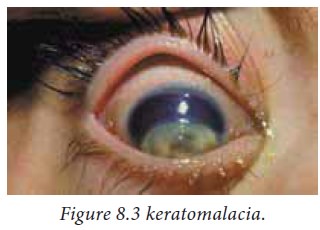
2. Vitamin D:
Vitamin D is a sterol compound. It is
represented by a group of steroids occuring chiefly in animals, plants and
yeast. There are two distinct forms of Vitamin D, namely Vitamin D2
and Vitamin D3. Vitamin D3 is more active than D2.
Vitamin D2:
Vitamin D2 is also known
as ergocalciferol. It is produced by the exposure of ergosterol to UV
radiation. Ergosterol occurs in plants, milk and yeast.
Vitamin D3:
Vitamin D3 is also known
as cholecalciferol. It is the natural form of the vitamin ingested from food.
It can also be formed by the exposure of 7-dehydrocholesterol present in the
skin to sunlight (UV radiation).
Transformation
from inactive provitamin D to the active form is accomplished by exposure to
sunlight(UVrays).
Cholecalciferolis
converted to calcifediol(25-hydroxycholecalciferol) in the liver. Similarly,
Ergocalciferol is converted to 25-hydroxyergocalciferol. These calicifediols
are further hydroxylated to form calcitriols (1,25-dihydroxy cholecalciferol 1,25-dihydroxy ergocalciferol), the
biologically active form of vitamin D. The calcitriol circulates as a hormone
in the blood.
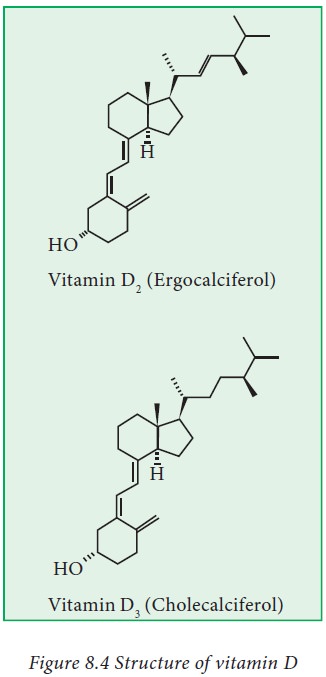
Sources:
Fish
liver oil is the richest source of vitamin D. Milk, butter and egg yolk also
contain considerable quantity of vitamin D (Fig. 8.5).
Egg yolks: 3- 10 microgram/g
Functions:
·
Vitamin D is required for normal growth in mammals. This is probably
related to absorption and utilization of calcium and phosphorous.
·
It helps in the normal development of bone and teeth.
Absorption and storage
Vitamin
D absorption occurs from small intestine. Fat and bile are essential for its
absorption. Vitamin D enters into the general circulation via lymph and stored
mainly in liver and kidneys.

Deficiency:
Deficiency
of this vitamin causes rickets in growing children and osteomalacia in adults
(Fig. 8.6). It is due to softening of bones resulting from lack of calcium and
phosphate.
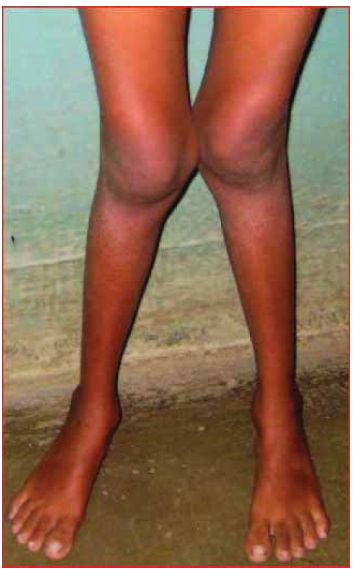
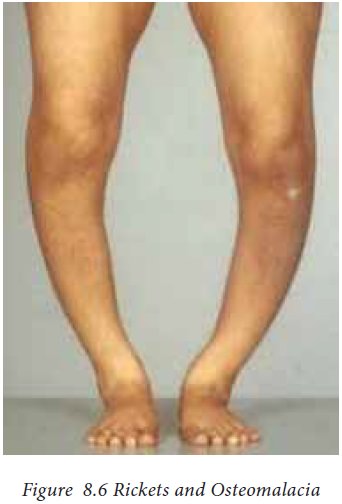
Toxicity:
Vitamin
D toxicity can occur if one consumes over 10,000 IU per day (1000 IU per day in
children) for several months. This causes hypervitaminosis D, which increases
the blood calcium levels. This results in bone loss and kidney stones.
Long-term overconsumption of vitamin D can cause calcification of organs such
as the heart, blood vessels and the kidneys.
3. Vitamin E:
Vitamin
E comprises of a group of isoprenoid substituted compounds called tocopherols
(Fig. 8.7). It also includes tocotrienols. The most common form of vitamin E is
alpha tocopherol which is present in large quantities in human body. The most
abundant form of vitamin E in diet is gamma tocopherol.

Sources:
Cotton
seed oil, sun flower oil, wheat germ oil and leafy vegetables are the rich
natural sources (Figure. 8.8).
Groundnut
oil: 261mg/100g
Wheat
germ oil: 150 mg/100g
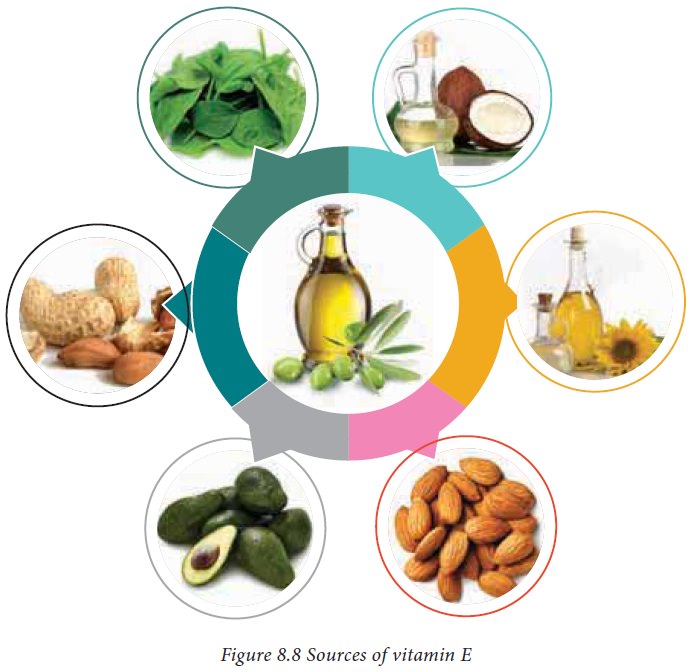
Functions:
Antioxidant property:
Vitamin
E is involved in removal of free radicals and prevents their effects on
unsaturated lipids of membrane and thus helps maintain the integrity of cell
membrane.
·
It protects the red blood cells against hemolysis.
·
It plays a role in normal functioning of muscles.
·
Vitamin E is essential for reproductive processes.
·
It plays an important protective role during ageing of cells.
·
Vitamin E is essential for biosynthesis of coenzyme Q.
Absorption and storage:
Vitamin
E, like other fat soluble vitamins, is absorbed along with fat in the small
intestines. It is stored in the liver, muscle and body fat.
Deficiency:
Vitamin E deficiency causes the following
conditions in animals.
·
Reproductive failure
·
Muscular dystrophy
·
Combined deficiency of vitamin E and selenium causes hepatic necrosis.
4. Vitamin K:
Vitamins
belonging to the K group are poly isoprenoid substituted naphthoquinones.
It is
known as the anti-hemorrhagic vitamin.
Three
compounds which have the biological activity of vitamin K are:
·
Phylloquinone,which is found in green leafy vegetables.
·
Menaquinones, which are a family of closely related compounds
synthesized by the intestinal bacteria, with different lengths of the side
chain.
·
Menadione, a synthetic compound which can be metabolized to yield
phylloquinone.
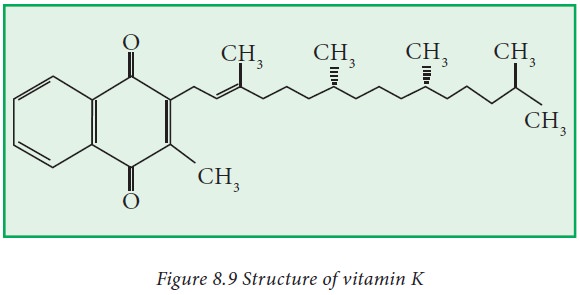
Sources:
Green
vegetables, soybean oils, tomatoes, spinach and cabbage are chief plant sources
(Fig. 8.10).

Functions:
· Vitamin K is essential for the synthesis of
prothrombin, a substance necessary for blood clotting. That is why it is called
as an anti-haemorrhagic vitamin.
· Vitamin K is needed to carboxylate specific
glutamate residues of calcium binding proteins of bones, spleen and kidneys.
This enhances the capacity of these proteins to deposit calcium in the tissues
concerned.
· It plays a key role in the respiratory chain
mechanism and oxidative phosphorylation.
Absorption and storage
Absorption
occurs in intestine. Being fat-soluble, its absorption is enhanced by
sufficient amount of bile salts. mainly in the jejunum by the way of lymphatus.
Liver stores appreciable amounts of vitamin K.
Deficiency:
· Deficiency of vitamin K is very rare, as most of
the daily foods contain this vitamin. In addition, intestinal flora of micro
organisms synthesize adequate quantity of vitamin K.
· The deficiency of vitamin K leads to a lowering of
prothrombin level and increased clotting time of blood. This may lead to
hemorrhagic conditions (Figure. 8.11).

Related Topics